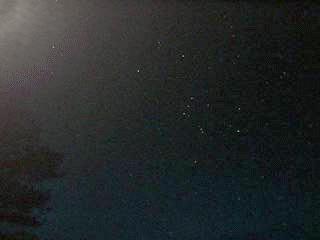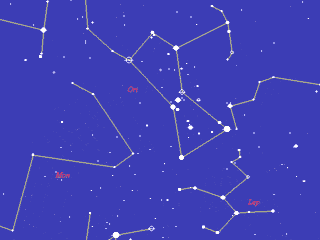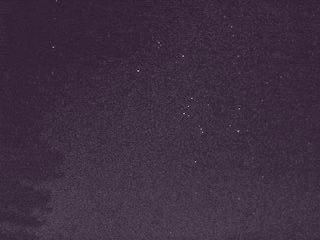Using a Kodak DC-120 for Astrophotography
There is no doubt that commercial digital cameras cannot match the
performance of dedicated astronomical CCD cameras. Custom astrocameras use
active cooling to significantly reduce CCD dark current and allow much
longer exposures. Even though they are not ideal for the purpose there are
a few things which you can hope to do with a digital camera with or
without a telescope. If you want to do good astrophotography the best
advice is buy a proper CCD camera designed for the purpose. On the other
hand if you want to see what can be done with a good commercial digital
camera then read on. One of the best features here is that no film is
wasted by poor shots and feedback is immediate. The worst feature is
fighting with peculiar little buttons in the dark.
The Kodak DC-120 is unusual in that it allows a wide range of exposure
control from 1/500s to 16s duration and has a relatively good fast f2.5
zoom lens. It also allows readback of the entire CCD array without
compression which is helpful when looking at high contrast sharp stars on
a black background. I have found in most cases the highest quality
compression does not produce seriously annoying artefacts (the other
settings are hopeless for astro work).
The simplest test of the camera is to try a star trail time exposure of
a familiar constellation and then compare the image with a star chart.
This test shows that at 16s exposure the camera is sensitive enough to
capture images of stars down to 5.5 magnitude. Unfortunately, the camera
also picks up a distracting ghostly glow in one corner of the CCD array.
There are also a number of "warm" pixels which are always bright
on each and every long time exposure taken with a particular camera. These
could easily be mistaken for stars.
Note that both these problems are peculiar to long time exposures made
using an uncooled CCD chip and this in no way affects or interferes with
normal use of the camera for photography in normal lighting conditions.


Constellation of Orion DC-120 wide angle f2.5 16s The dark object at
bottom left is the silhouette of a tree. A large scale version of the
images showing more detail at 640x480 resolution is also available (approx
80kb).
Orion pictures
Star map produced using Chris Marriott's SkyMap Pro v4.0, details
available from
SkyMap
Stars are shown down to 6th magnitude
Warm pixels are caused by leakage of charge from a few individual CCD
pixels and this effect occurs faster at more elevated temperatures. This
is one of the main reasons why low noise astro cameras are actively
cooled. Most pixels are affected to a much lesser extent and it gives rise
to a coloured mottling of the background noise.
The radially striped bright corner effect was explained to me by a CCD
specialist as being due to low levels of infra red emission from the CCD's
analogue amplifier circuitry. CCD's are rather sensitive to IR and so on a
long exposure this effect will eventually show up even on top astro CCD
cameras (after an hour or so). Some CCD's chips have better low leakage
and long exposure performance than others, but most digital camera
manufacturers are not brave enough to allow exposures which would allow
these effects to be seen. I think this is a pity.
Fortunately the majority of the dark current glow and "warm"
pixels signal is very reproducible on successive shots, and it is quite
practical to take a dark frame to subtract from the sky image in post
processing. This allows quite reasonable images of constellations to be
obtained to about the same depth as an ordinary observer can see in a
moderately dark suburban sky.

This is the final image after dark frame subtraction. It is
significantly more pleasing.
It is not possible to use the DC-120 at prime focus as there is no easy
way to remove the standard lens. This means you need to use a rather
clumsy procedure of photographing through the eyepiece and telescope.
There is some risk of telescope eyepiece and camera lens colliding whilst
doing this sort of photography as the scope tracks the object it may move
the eyepiece towards the camera if you are not careful.
It is not helped by the lack of a cable release input on the camera so
that many otherwise good manual shots can be spoiled by vibration. You can
control the camera from a PC but I have not used that for these tests.

This is a shot of Jupiter taken in twilight at 16:56 on 16th January
1998 which just about shows two of the Galilean satellites at about 4
o'clock from the main disk. It was taken through my 1000mm f10 Maksutov
lens using a 10mm eyepiece. Four belts were clearly visible through the
scope, but unfortunately the camera exposure did not capture them at all.
The problem is primarily due to camera shake and atmospheric turbulence on
an exposure of 1s. Shorter exposures failed to capture sensible colour
information and were an odd shade of green.
I plan to get some better shots of Saturn with the 10" next time it
is clear.

This is a shot of the moon taken at 18:18UT on 2nd February 1998 with my
Meade LX200 10" f6.3 with a 35mm eyepiece which gave a wide field and
a bright enough image to get a one decent exposure at 1/15s before weather
intervened and I had to beat a hasty retreat. The image is over exposed,
and the automatic exposure proved to be useless at these light levels. And
again the level of detail visible in the image is rather disappointing
compared to the crisp visual image in the telescope. A shorter exposure
would doubtless give better resolution and more detail away from the
terminator. Unfortunately, big fat rain clouds intervened.
The manual shutter control also proved to be something of a pain to use
as the exposure shift only allows easy movement to ever longer exposures
(so that changing from 1/8s to 1/15s exposure requires 20 fiddly
keystrokes). It seems from the legends on the back panel that this was
perhaps not the original intention, but only the cursor down key works!
Perhaps it is a defect with my camera - does anyone else have this problem
with manual exposures?
The best way to get started is using a long focal length eyepiece with
good eye relief so that alignment is less critical and there is less
chance of accidental collisions between camera lens and telescope.
Unfortunately, the cameras preview function does not work very well at low
light levels and so you have to take shots blind after making the trying
to align the optic axes of camera and telescope. This is harder to do
than it sounds and a high proportion of my initial attempts were entirely
blank! I am sure it will be possible to improve on my initial efforts
using this camera for astro shots given enough time and patience.
I think the conclusion is that the DC-120 is not ideal as an
astronomical camera, but if you happen to have one there is a possibility
to take simple shots of constellation star fields and telescopic shots of
the moon and planets. Do not buy one solely for the purpose of low light
astrophotography. I am well pleased with mine for general use and put this
page together with a few sample images to show what can be done at low
light levels. Deep sky photography is basically not practical because of
the maximum 16s exposure, but I am sure that better planetary and lunar
images would be possible with more practice. The limitation at present is
one of technique.
More DC-120
low light images showing the
from the late twilight sky with the planets at a range of exposures from 1
to 16 seconds. Note how the underexposed images show extra noise and
pronounced colour casts to green. Also a more conventional night shot of
my southern outlook by available light at 16s exposure.
Broadly speaking the DC-120 can see roughly as well as a partially dark
adapted human eye in suburban skies.
Other astronomical info -
Nonad filters for eliminating low
pressure Sodium light pollution.
Nacreous cloud observations


Send feedback suggestions and comments to
Martin Brown
Last modified 3rd September 1998





